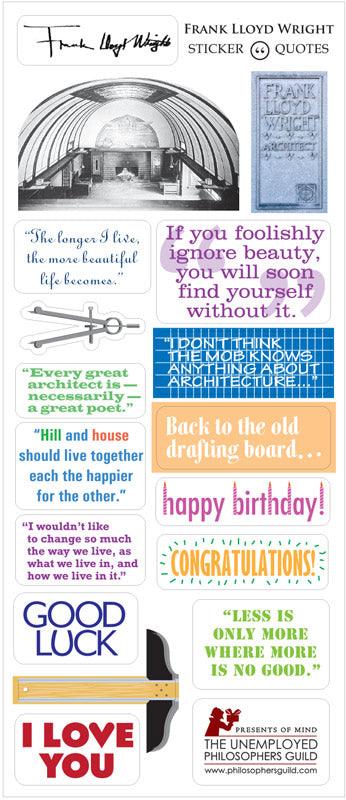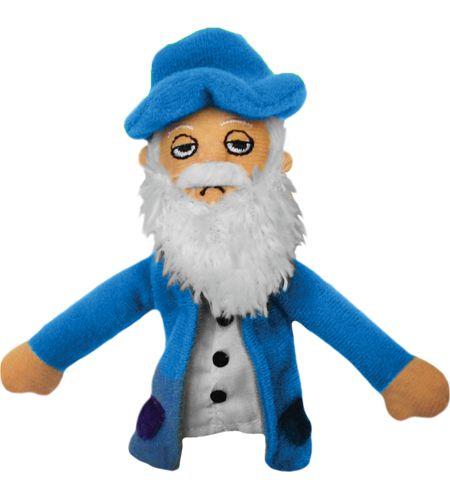Frank Lloyd Wright Die-Cut Notecard with Stickers
Frank Lloyd Wright Die-Cut Notecard with Stickers
The Unemployed Philosopher's Guild
En existencias
No se pudo cargar la disponibilidad de retiro
Now you can send Frank Lloyd Wright to deliver all your big plans and wild ideas with this handsome Quotable Notable card.
Quotable Notable die-cut greeting card sets feature the portrait of a famous figure on the front and a mini biography on the back. No time to write? There's a sticker sheet of quotes and images with friendly greetings like "Happy Birthday!" and "Good Luck!
- Includes envelope and sticker sheet
Product Details
Product Details
- Product type: Blank Note Card
- Shipping Dimensions: 8.75 × 4.0 (22.2 × 10.2 cm)
- Shipping Weight: 0.06 lb (1.0 oz; 28 g)
- SKU: SKU: SKU010010989
- UPC: 814229003564
- Part No.: 0589
In these collections: Blank Cards, El gremio de filósofos desempleados, Frank Lloyd Wright, Gifts Under $10, Tarjetas de felicitación y notas, and Todos los productos.
Share



About the
Frank Lloyd Wright
Frank Lloyd Wright (1867-1959) remains an iconic figure in American architecture and design. Born in Richland Center, Wisconsin, Wright's career spanned over seven decades and left an indelible mark on the world of architecture. He was known for his visionary approach, pioneering organic architecture that seamlessly integrated buildings with their natural surroundings. Wright's most famous works include Fallingwater, a masterpiece of modern architecture built over a waterfall in Pennsylvania, and the Guggenheim Museum in New York City, which features a distinctive spiral design. His unique style, characterized by clean lines, open spaces, and innovative use of materials, has influenced countless architects and continues to inspire generations of designers worldwide. Wright's legacy as an architectural genius and his commitment to a harmonious relationship between nature and structures have solidified his place as one of America's most revered architects.
More Frank Lloyd Wright
-
Frank Lloyd Wright Coonley Playhouse Earrings
Precio habitual £30.35 GBPPrecio habitualPrecio unitario / por -
Frank Lloyd Wright Wood Domino Set
Precio habitual £30.34 GBPPrecio habitualPrecio unitario / por -
Opposites with Frank Lloyd Wright
Precio habitual £9.86 GBPPrecio habitualPrecio unitario / por -
My First Shapes with Frank Lloyd Wright Board Book
Precio habitual £9.86 GBPPrecio habitualPrecio unitario / por -
Frank Lloyd Wright Painting Kit
Precio habitual £11.37 GBPPrecio habitualPrecio unitario / por -
Frank Lloyd Wright My First Shapes Crinkle Fabric Stroller Book
Precio habitual £9.86 GBPPrecio habitualPrecio unitario / por -
Frank Lloyd Wright Frozen Spheres 500 Piece Foil Puzzle
Precio habitual £12.89 GBPPrecio habitualPrecio unitario / por -
Frank Lloyd Wright Hillside Curtain 1500 Piece Foil Puzzle
Precio habitual £18.96 GBPPrecio habitualPrecio unitario / por -
Frank Lloyd Wright "Hoffman Rug" Expandable Vase
Precio habitual £9.10 GBPPrecio habitualPrecio unitario / por -
Frank Lloyd Wright "March Balloons" Expandable Vase
Precio habitual £9.10 GBPPrecio habitualPrecio unitario / por

About the Brand
The Unemployed Philosopher's Guild
The origins of the Unemployed Philosophers Guild are shrouded in mystery. Some accounts trace the Guild's birth to Athens in the latter half of the 4th century BCE. Allegedly, several lesser philosophers grew weary of the endless Socratic dialogue endemic in their trade and turned to crafting household implements and playthings. (Hence the assertions that Socrates quaffed his hemlock poison from a Guild-designed chalice, though vigorous debate surrounds the question of whether it was a "disappearing" chalice.)
Others argue that the UPG dates from the High Middle Ages, when the Philosophers Guild entered the world of commerce by selling bawdy pamphlets to pilgrims facing long lines for the restroom. Business boomed until 1211 when Pope Innocent III condemned the publications. Not surprisingly, this led to increased sales, even as half our membership was burned at the stake.
More recently, revisionist historians have pinpointed the birth of the Guild to the time it was still cool to live in New York City's Lower East Side. Two brothers turned their inner creativity and love of paying rent towards fulfilling the people's needs for finger puppets, warm slippers, coffee cups, and cracking up at stuff.
Most of the proceeds go to unemployed philosophers (and their associates). A portion also goes to some groups working on profound causes.
-
Museum Store Association Member
The Museum Store Association supports the cultural non-profit retail industry and the people who work in it.
-
Supports Non-profit Organizations
A portion of proceeds is donated to non-profit organizations. See description for details.
-
Designed in USA
Designed in the USA, with global manufacturing or assembly.
More from The Unemployed Philosopher's Guild
-
Marioneta de dedo magnética de Bob Ross
Precio habitual £6.79 GBPPrecio habitualPrecio unitario / por -
Marioneta de dedo magnética Frida Kahlo
Precio habitual £6.79 GBPPrecio habitualPrecio unitario / por -
Copa de Arte Moderno
Precio habitual £15.14 GBPPrecio habitualPrecio unitario / por -
Frida Dreams Mug
Precio habitual £15.14 GBPPrecio habitualPrecio unitario / por -
Diego Rivera Magnetic Finger Puppet
Precio habitual £6.79 GBPPrecio habitualPrecio unitario / por -
James Baldwin "Little Thinker" Plush Doll
Precio habitual £18.21 GBPPrecio habitualPrecio unitario / por -
Tarjeta de notas troquelada de Rembrandt con pegatinas
Precio habitual £3.00 GBPPrecio habitualPrecio unitario / por -
Marioneta de dedo magnética de Claude Monet
Precio habitual £6.79 GBPPrecio habitualPrecio unitario / por -
Marioneta de dedo magnética de James Baldwin
Precio habitual £6.79 GBPPrecio habitualPrecio unitario / por -
Marioneta de dedo magnética de Vincent van Gogh
Precio habitual £6.79 GBPPrecio habitualPrecio unitario / por






















